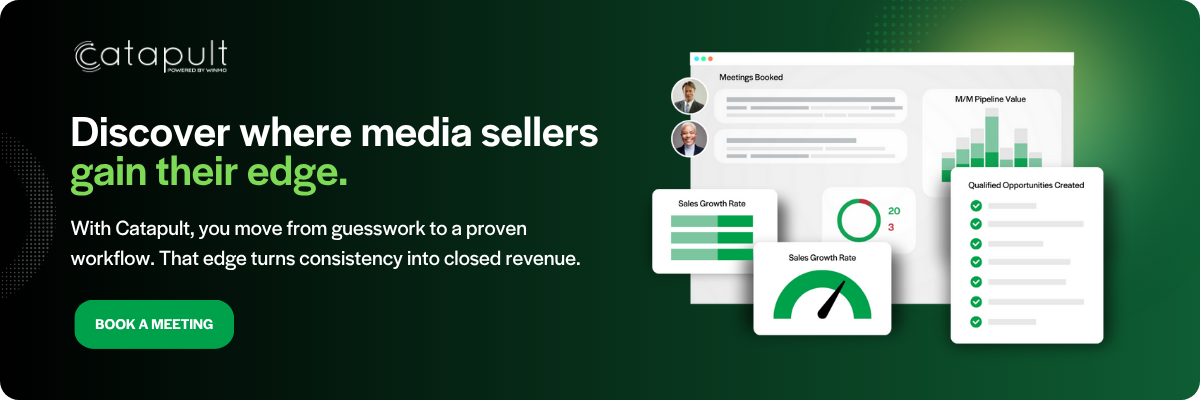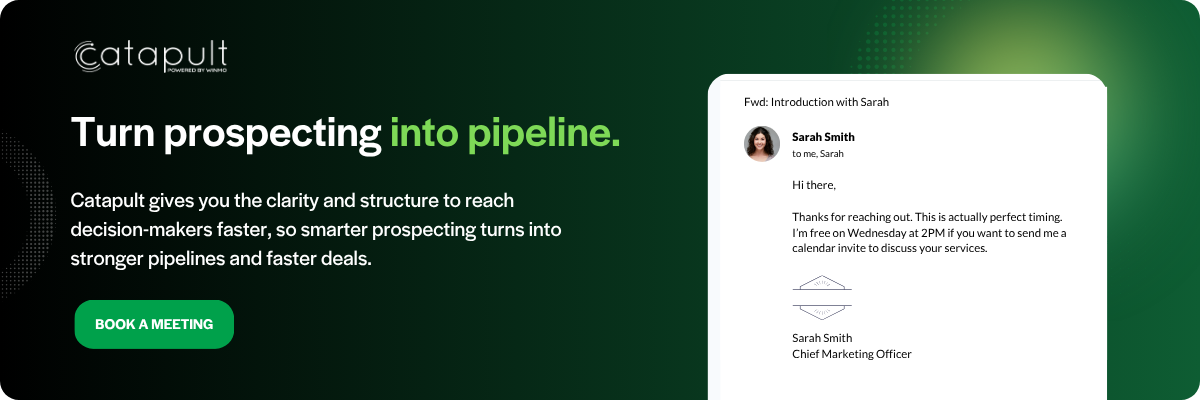If you’re in media sales, you’ve probably lost hours chasing the wrong people. You email a Marketing Manager who has no control over budget. You build rapport with an agency contact, but the brand makes the final call. By the time you figure out who actually owns the dollars, the buying window is closed.
You’re not alone; 42% of salespeople say prospecting is their biggest challenge. And in media sales, the challenge is even tougher. Buying decisions are split across brands and agencies, job titles are misleading, and gatekeepers slow everything down. That wasted time drags out your pipeline and kills deal velocity.
There’s a smarter way. By combining org charts, proactive sales strategies, and buyer intent data, you can cut through the noise, zero in on real decision-makers, and learn how to reach B2B decision makers faster. That’s what this guide will cover, step by step.
Media Sales Top 3 Challenges: Why It’s So Hard to Reach the Right B2B Decision Makers
Before you can fix your prospecting process, you need to understand what’s slowing you down. As a media seller, you’re facing a perfect storm: too many stakeholders (on average, 11 people are involved in a single B2B buying decision), titles that don’t reflect real authority, and gatekeepers who stall deals before they start. Each of these challenges chips away at your time and pipeline velocity.
1. Complexity of media buying
You’re not pitching into a simple buying cycle. Every deal involves a mix of players:
- CMOs deciding brand direction
- Agency leads managing the execution
- Directors of partnerships owning specific initiatives
- Procurement teams holding the purse strings
Miss one of these voices, or worse, focus on the wrong one, and you risk losing weeks while your competitors move in.
2. Misleading titles
On paper, a title looks promising. In reality, it tells you very little about budget control.
- A Marketing Manager might look like the right contact, but their world could be content calendars, not paid media.
- A Director could be the budget owner at a startup or a layer of middle management at a Fortune 500.
- A VP of Media might own spend on the brand side, while that same title on the agency side manages client execution with no budget authority.
When you rely on titles alone, you’re gambling with your time.
3. Gatekeepers and slow processes
Even when you connect with someone enthusiastic, they may not have the authority to move dollars. Approvals bounce between agency and brand, with gatekeepers blocking the path. That’s why 40% of sellers say prospecting is harder than closing.
- Administrative assistants screening your calls and emails
- Mid-level managers passing along your pitch but never escalating it
- Layers of brand and agency approvals that stretch timelines
In media sales, guesswork kills your deals. You need visibility into who truly makes the call so you can spend your time where it matters: getting in front of B2B decision makers.
How to Reach Media Decision Makers Faster
Instead of chasing titles that go nowhere, you need a process that helps you see the full media buying committee, focus only on the roles that matter, and engage them with the right tools. The steps below break down exactly how to do it.
Step 1: Use org charts to map the buying committee
You can’t afford to guess who has the power to say yes. That’s where org charts come in. They show you who reports to whom, who influences decisions, and who ultimately controls budget. For media sellers, org charts are your shortcut to reaching decision-makers faster.
Why it matters:
- Reveals the difference between influencers and true decision-makers
- Gives you multiple paths into an account, so you’re not stuck with one contact
- Helps you build a multi-threaded outreach strategy, which dramatically improves win rates
Media sales angle:
- Spot how the VP of Brand Partnerships connects directly to the CMO
- See whether decisions are being made at the brand level or pushed through the agency
- Use platforms like Winmo, MediaRadar, or internal mapping systems to keep orgs up to date
Example: You identify that the Director of Sponsorships reports to the VP of Marketing, who rolls up to the CMO. That’s three warm entry points you can use to build credibility and momentum.
Step 2: Target the right titles with precision
Once you’ve mapped the org chart, the next step is to pinpoint the titles that matter most. This is where you shift from a broad list of contacts to a focused group of decision-makers who own budgets or run RFPs. By narrowing your outreach to these roles, you cut through noise and move faster toward real conversations.
Why it matters:
- Broad targeting fills your pipeline with contacts who can’t move budget
- Precision targeting gets you in front of decision-makers faster
- The right titles give you leverage to accelerate deals
High-value media buyer titles:
- CMO: Owns overall marketing strategy and budget authority.
- VP of Media: Directs media planning and major spend decisions.
- Director of Paid Media: Manages paid campaigns and controls ad spend.
- Director of Brand Partnerships: Leads sponsorships and brand-to-brand deals.
- Head of Agency Partnerships: Oversees relationships with outside agencies.
- Media Investment Lead (agency-side): Allocates client budgets across media buys.
Not every role on the org chart deserves equal attention. Focus first on the titles that consistently sit closest to budget. These are the decision-makers who either own spend directly or oversee RFPs. Everyone else is secondary.
Step 3: Equip yourself with the right outreach tools
Top media sellers rely on tools that make prospecting faster, sharper, and more effective. The right stack helps you scale personalization, automate follow-ups, and time your outreach to when decision-makers are most likely to respond.
Why it matters:
- Modern platforms allow personalization at scale without spray-and-pray messaging
- Enrichment and intent data highlight which accounts are worth your time
- Teams using two or more enrichment tools see higher engagement
- Seventy-eight percent of sellers report better response rates when combining email, LinkedIn, and phone
Tools that work:
- CRM and enrichment (HubSpot, Salesforce, Clearbit, Apollo): Organize accounts and contacts, enrich profiles with direct dials and emails, and sync notes from calls or LinkedIn outreach.
- Sales intelligence (ZoomInfo, Winmo, MediaRadar): Surface brands and agencies planning campaigns, track competitor spend, and uncover partnership opportunities.
- Outreach automation (Salesloft, Outreach.io, Instantly): Run sequences that combine email, LinkedIn, and phone, personalize at scale, and automate follow-ups.
- Intent data (Bombora, 6sense): Identify accounts researching media partnerships, prioritize high-intent prospects, and schedule outreach to coincide with budget cycles.
With the right tools in place, you spend less time chasing and more time connecting with decision-makers who are ready to move budget.
Bringing It All Together: Your Streamlined Media Sales Prospecting Workflow
You don’t need a complicated playbook to improve deal velocity in media sales. What you need is a repeatable system you can run on every account. Use this workflow to keep your prospecting sharp, efficient, and focused on decision-makers who control spend.
1. Identify your target account
Clarity on who you’re selling to is the foundation of proactive sales. Decide early whether the dollars sit with the brand, the agency, or both.
- Target brands planning new campaigns or sponsorships
- Track agencies managing media buying for high-value accounts
- Use B2B intent data to confirm which accounts are actually in-market
2. Map the org chart
Once you’ve chosen the account, map the people involved. Your goal is to see the buying committee clearly before you start outreach.
- Chart who reports to whom, so you know where budget authority lives
- Flag influencers versus decision-makers
- Update regularly to avoid chasing outdated contacts
3. Target 2–3 high-value roles
Precision targeting puts you in front of the people who can move money.
- Focus on titles with budget ownership or RFP control (CMO, VP of Media, Director of Paid Media, etc.)
- Rank contacts by decision-making power and influence
- Avoid spreading your efforts thin across too many titles
4. Engage across multiple channels
Relying on one channel slows response time. A multi-channel approach accelerates conversations.
- Pair email with LinkedIn messages and phone calls
- Keep messaging consistent across touchpoints
- Use outreach tools to schedule and track your sequences
5. Personalize with buyer intent
Context is what separates noise from relevance. Buyer intent data helps you deliver outreach when it matters most.
- Prioritize accounts signaling active interest in media partnerships
- Reference recent activity or industry shifts in your messaging
- Time follow-ups to align with budget planning windows
Run this workflow consistently and you’ll reduce wasted effort, create more qualified conversations, and accelerate deals in media sales.

Conclusion: Start Hitting Your Media Quota With or Without an In-House Team
Reaching media decision-makers requires both structure and persistence. With a smarter prospecting system, built on org charts, precision targeting, buyer intent data, and the right tools, you can reach decision-makers faster and turn cold outreach into warm opportunities.
If building that system sounds like a full-time job, that’s because it is. Catapult handles it for you. We run the outreach engine, manage the data, and put your media company in front of budget owners every week. You get qualified meetings without the lift of building a team from scratch.
Ready to stop chasing ghost contacts and start booking meetings with buyers who actually move budget? Book a meeting with Catapult, and let’s talk about building your next wave of growth.

Proactive sales is about reaching decision-makers before an RFP ever hits your inbox. Instead of waiting for inbound leads, you use org charts, buyer intent data, and multi-channel outreach to get ahead of demand.
Buyer intent data shows which accounts are actively researching or planning campaigns. This lets you focus outreach on decision-makers who are more likely to buy, increasing efficiency and deal velocity.
Start with org charts to map the committee, then target 2–3 high-value roles. Use multi-channel outreach supported by sales intelligence tools and intent signals to break through faster.
Begin with a CRM to track accounts, a sales intelligence platform for data, and an outreach tool to manage sequences. Add intent data for sharper targeting. Sellers using multiple enrichment tools report higher engagement.
Lorem ipsum dolor sit amet, consectetur adipiscing elit. Ut elit tellus, luctus nec ullamcorper mattis, pulvinar dapibus leo.

